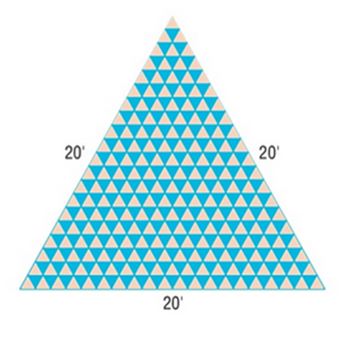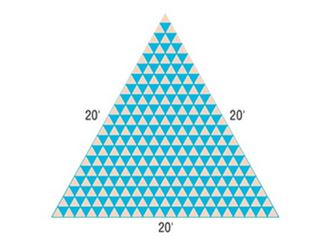
Concept explainers
Creating a Mosaic A mosaic is designed in the shape of an equilateral triangle, 20 feet on each side. Each tile in the mosaic is in the shape of an equilateral triangle, 12 inches to a side. The tiles are to alternate in color as shown in the illustration. How many tiles of each color will be required?

To find: A mosaic is designed in the shape of an equilateral triangle, 20 feet on each side. Each tile in the mosaic is in the shape of an equilateral triangle, 12 inches to a side. The tiles are to alternate in color as shown in the illustration. How many tiles of each color will be required?

Answer to Problem 61AYU
Blue colour .
Beige colour .
Explanation of Solution
Given:
A 20 feet mosaic of equilateral triangle is filled with two coloured triangular tiles of 12 inches.
Formula used:
The th term of an arithmetic sequence can be found by the formula
(Formula 1)
Sum of the first terms of an arithmetic sequence
(Formula 2)
Calculation:
From the figure and the given data, the total number of rows is .
There are two sequences in the problem: one for blue and one for beige.
Sequence for blue coloured tile:
Since Blue coloured tiles start from second row, the total number of rows .
Therefore the first sequence is .
Therefore, the total number of blue coloured tiles (By formula 2)
Sequence for beige coloured tile:
Since beige coloured tiles start from first row, the total number of rows .
Therefore the second sequence is .
Therefore, the total number of beige coloured tiles (By formula 2)
Chapter 12 Solutions
Precalculus Enhanced with Graphing Utilities
Additional Math Textbook Solutions
Elementary Statistics (13th Edition)
Elementary Statistics: Picturing the World (7th Edition)
Thinking Mathematically (6th Edition)
A First Course in Probability (10th Edition)
Elementary Statistics
Intro Stats, Books a la Carte Edition (5th Edition)
- Perform long division on the integrand, write the proper fraction as a sum of partial fractions, and then evaluate the integral. 30x³-60x²+8 dx 2 x-2x After performing the long division, write the resulting proper fraction as a sum of partial fractions. Evaluate the integral. 30x³-60x²+8 2 x² -2x dx=arrow_forwardEvaluate the following integral. x/6 S tan 2x dx x/12arrow_forwardEvaluate the integral by using a substitution prior to integration by parts. 7) sin (In (6x)) dxarrow_forward
- Evaluate the integral using any appropriate algebraic method or trigonometric identity. S- dy 18 √2 (1+y2/3) yarrow_forward4. Suppose the demand for a certain item is given by D(p)=-2 p² - 4p+350, where p represents the price of the item in dollars. a) Find the rate of change of demand with respect to price. b) Find and interpret the rate of change of demand when the price is $11.arrow_forward√3-x, x≤3, 2. For f(x) = 1 find each of the following. x > 3, x-3' 1. f(-6) 2. f(3) 3. f(7) 3. Find the domain of each of the following functions.arrow_forward
- 1. Using the definition of the derivative, find f'(x). Then find f'(2), f'(0) and f'(3) when the derivative exists. a) f(x)=5x²-6x-1arrow_forward2. f(x)=√7-x 4. A manufacturer has a monthly fixed cost of $40,000 and a production cost of $8 for each unit produced. The product sells for $12 per unit. 1. What is the cost function? 2. What is the revenue function? 3. Compute the profit corresponding to 12,000 units. 5. A rectangular box is to have a square base and a volume of 20 ft3. The material for the base costs $0.30 per ft2, the material for the sides cost $0.10 per ft2, and the material for the top costs $0.20 per ft2. Letting x denote the length of one side of the base,arrow_forwardSolve using superposition principlearrow_forward
 Calculus: Early TranscendentalsCalculusISBN:9781285741550Author:James StewartPublisher:Cengage Learning
Calculus: Early TranscendentalsCalculusISBN:9781285741550Author:James StewartPublisher:Cengage Learning Thomas' Calculus (14th Edition)CalculusISBN:9780134438986Author:Joel R. Hass, Christopher E. Heil, Maurice D. WeirPublisher:PEARSON
Thomas' Calculus (14th Edition)CalculusISBN:9780134438986Author:Joel R. Hass, Christopher E. Heil, Maurice D. WeirPublisher:PEARSON Calculus: Early Transcendentals (3rd Edition)CalculusISBN:9780134763644Author:William L. Briggs, Lyle Cochran, Bernard Gillett, Eric SchulzPublisher:PEARSON
Calculus: Early Transcendentals (3rd Edition)CalculusISBN:9780134763644Author:William L. Briggs, Lyle Cochran, Bernard Gillett, Eric SchulzPublisher:PEARSON Calculus: Early TranscendentalsCalculusISBN:9781319050740Author:Jon Rogawski, Colin Adams, Robert FranzosaPublisher:W. H. Freeman
Calculus: Early TranscendentalsCalculusISBN:9781319050740Author:Jon Rogawski, Colin Adams, Robert FranzosaPublisher:W. H. Freeman
 Calculus: Early Transcendental FunctionsCalculusISBN:9781337552516Author:Ron Larson, Bruce H. EdwardsPublisher:Cengage Learning
Calculus: Early Transcendental FunctionsCalculusISBN:9781337552516Author:Ron Larson, Bruce H. EdwardsPublisher:Cengage Learning





